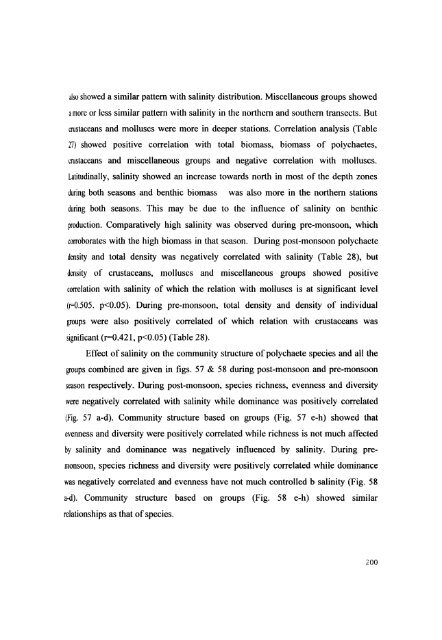- Page 2 and 3:
Certificate I hereby certify that t
- Page 4 and 5:
Contents Page No. Chapter 1. Introd
- Page 6:
the bottom. Ekman (1935) described
- Page 9 and 10:
wonns are the most abundant group a
- Page 11 and 12:
leadership of Sir James Clark Ross,
- Page 13 and 14:
Ansari et al., (1977b) carried out
- Page 15 and 16:
Gopalakrishnan and Nair (1998) cond
- Page 17 and 18:
Major objectives:- 1. To understand
- Page 19 and 20:
CMFRI (Central Marine Fisheries Res
- Page 21 and 22:
Joydas, T.V., Damodaran, R., 2001.
- Page 23 and 24:
monitoring committee (Atlantic Mari
- Page 25 and 26:
Vizakat Lathika, I-Iarkantra, S. N.
- Page 28 and 29:
analysed after acidification by tit
- Page 30:
used as stain prior to sorting and
- Page 33 and 34:
space. Therefore, it is very essent
- Page 36 and 37:
Fig. I - Station locations 32
- Page 39 and 40:
affected at high temperature. Most
- Page 41 and 42:
layers exhibit different oceanograp
- Page 43:
Transect wise variation in temperat
- Page 46 and 47:
3.2.2.3. Dissolved oxygen (DO) Dist
- Page 48 and 49:
monsoon temperature initially incre
- Page 50 and 51:
opined that limited mixing. high or
- Page 52 and 53:
Naqvi, S. W. A., Noronha, R. J., Re
- Page 56:
orr Mormugao orr Vernal 35.36 35.32
- Page 62 and 63:
The continental shelf and its adjoi
- Page 64:
sediments (4 stations). Silty sand
- Page 68 and 69:
fine sediments with comparatively h
- Page 70 and 71:
Narayana, 1991 ). Limited input of
- Page 73 and 74:
In general. two ditlerent patterns
- Page 75 and 76:
et al., (1980) reported values in t
- Page 77 and 78:
organisms living in the water and t
- Page 79 and 80:
Hashimi, N. H., Kidwai, R. M., Nair
- Page 81 and 82:
Postma, H., 1967. In Estuaries, Lau
- Page 85:
Depths Sand Silt Clay Organic matte
- Page 90:
• PRE'MONSOON SOUTHERN'TRANSECTS
- Page 96 and 97:
as the best indicators of the envir
- Page 99 and 100:
showed that northern transects have
- Page 101 and 102:
decreased from shallow to deeper de
- Page 103:
different depth zones showed that a
- Page 106 and 107:
cm 2 with a dominance of nematodes.
- Page 108 and 109:
and 6.08 g/m 2 were recorded during
- Page 110 and 111:
were located in the nearshore water
- Page 112 and 113:
changes in the hydrographical and t
- Page 114 and 115:
factor for such a large difference
- Page 116 and 117:
Belegvad, H., 1932. Investigations
- Page 118 and 119:
Parulekar, A. H., Harkantra, S. N.,
- Page 120:
Savich, M. S., 1972. Quantitative d
- Page 123 and 124:
Traosects Polychaetes Crustaceans M
- Page 125:
Miscellaneous Transects Nematodes C
- Page 128 and 129:
Depths Nematodes Cope pods Foramini
- Page 136 and 137:
Wagh, 1975; Parulekar et ai, 1976;
- Page 138 and 139:
ones and 17 were included in the 'r
- Page 140 and 141:
Nephtydae (2%). Among the 20 sedent
- Page 143 and 144:
At 75 m zone, 31 groups/species wer
- Page 145 and 146:
Porbandar. At 50 m depth zone, fluc
- Page 148 and 149:
otTMumbai and Ratnagiri and low eve
- Page 150 and 151:
species richness at each depth zone
- Page 153 and 154:
E2.2.2.!. Richness (Margalef's inde
- Page 155:
I ):.2.2.2.4. Dominance (Pie/ou's i
- Page 172 and 173: Tablc 17. Contd .. - Sternaspidae 0
- Page 176: Table 20. contd .. G. alba 20 25 20
- Page 179: 150 Taxa 30m 50m 75m lOOm 150 m m D
- Page 186: 9% 1% o poIychaete • crustacea o
- Page 203 and 204: a) c) e) g) Plate 5 a) Prinospio sp
- Page 205 and 206: a) c) e) Plate 7 a) Cardium sp. d)
- Page 207 and 208: 7/. /ntroduct ion 7.2. Hydrography
- Page 212 and 213: Many workers have suggested that sa
- Page 214 and 215: Decrease of benthos with DO agrees
- Page 216 and 217: crustaceans. This indicated that du
- Page 218 and 219: (1987) also found high population d
- Page 220 and 221: uue to the accumulation of OM (6%)
- Page 223: important parameters were graded as
- Page 226 and 227: Macrobenthos, by feeding on meioben
- Page 228 and 229: a life span of about 3 months (Saja
- Page 230 and 231: 7.7. References Ahlstrom, E. H., 19
- Page 232 and 233: Harkantra, S. N., Ayyappan Nair, An
- Page 234 and 235: Parulekar. A. H., Ansari, Z. A., 19
- Page 236 and 237: Polychaetes Crustaceans Molluscs M.
- Page 256 and 257: Chapter 8. Summary and conclusion T
- Page 259 and 260:
zones. Low biomass and density obse
- Page 261:
production will be more than that o

















